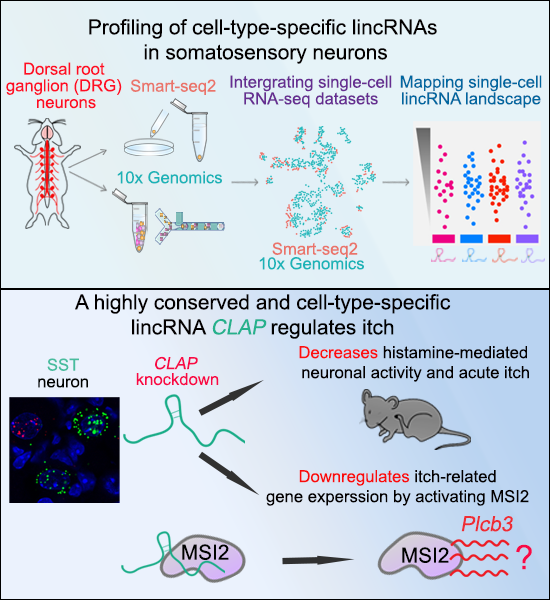Dorsal root ganglion (DRG) contains the cell body of somatosensory neurons that convey sensory information including thermal, mechanical and chemical stimuli from the peripheral afferents to the central nervous system for brain perception. Recent studies from our cooperated Prof. Xu Zhang’s lab classified DRG neurons into 10 types and 14 subtypes using single-cell RNA sequencing (scRNA-seq), and revealed cell-type-specific expression of modulator mRNAs in sensory transmission especially for mechanical transduction and itch (Li et a., Cell Research, 2016; Wang et al., Cell Research, 2021). However, the precise regulatory mechanisms underlying cell-type-specific sensory transmission remain largely unknown.
A subclass of lncRNAs, long intergenic noncoding RNAs (lincRNAs) transcribed from intergenic regions, have been recently shown to play pivotal roles in different biological processes. Bioinformatic analysis reveals that lincRNAs exhibit tissue specificity compared with mRNAs especially in the brain, implying possible fine-tuning of lincRNAs in a tissue- and cell-type-specific manner. Therefore, it is important for investigating the distribution and function of cell-type-specific lincRNAs in DRG neurons.
The work entitled “Somatosensory neurons express specific sets of lincRNAs, and lincRNA CLAP promotes itch sensation in mice” was published online in EMBO Reports on December 16, 2022. WANG Bin at the Guangdong Institute of Intelligent Science and Technology (GDIIST), JIANG Bowen and LI Guowei and their colleagues, under the supervision of Prof. BAO Lan at the Center for Excellence in Molecular Cell Science, CAS, and Prof. LI Yang at the Institutes of Biomedical Sciences, Fudan University, found that hundreds of highly expressed lincRNAs were characterized in distinct types and subtypes of mouse DRG neurons, and a highly conserved lincRNA CLAP specifically expressed in somatostatin-positive neurons regulated histamine-mediated neuronal activation, acute itch and cell-type-specific gene expression.
In the present study, combined our scRNA-seq datasets from droplet-based (also known as 10x Genomics) and full-length Smart-seq2, we firstly constructed a single-cell lincRNA landscape of DRG cells and identified 200 lincRNAs highly expressed in distinct types and subtypes of mouse DRG neurons by applied specificity measure (SPM) analysis. We then validated the high-ranking lincRNAs in specific DRG neurons by using single-cell reverse transcription PCR (RT-PCR), single-molecular fluorescent in situ hybridization (smFISH) and fluorescent activating cell sorting (FACS) to purify specific neuronal type of somatosensory neurons. In addition, neuron-type-specific lincRNAs and their adjacent protein-coding genes were predominantly expressed in the same type of neurons. Thus, this coexpression pattern of neuron-type-specific lincRNAs with their adjacent mRNAs suggests their regulatory potential in somatosensory neurons.
Furthermore, we characterized a previously unknown lincRNA 9130409J20Rik, referred to as CLAP (Cell-type-specific LincRNA Associating with Pruritus), which was highly conserved and specifically expressed in somatostatin-positive neurons. CLAP knockdown reduced histamine-induced Ca2+ influx in cultured SST-positive neurons, and in vivo reduced histamine-induced scratching and itch-related gene expression in mice. Moreover, Mosashi RNA binding Protein 2 (MSI2) was identified to specifically bind CLAP in mouse DRGs and partially mediate itch-related gene expression regulated by CLAP.
This work was collaborated with Profs. ZHANG Xu, LI Changlin, HAN Qingjian and XU Zhenzhong.
This work was funded by National Natural Science Foundation of China, Guangdong High Level Innovation Research Institute and Innovation Fund for Medical Sciences of Chinese Academy of Medical Sciences.

scRNA-seq reveals cell-type-specific lincRNA in somatosensory neurons, and a highly conserved and cell-type-specific lincRNA CLAP involved in itch sensation
Contact: wangbin@gdiist.cn
Reference: https://www.embopress.org/doi/abs/10.15252/embr.202154313


